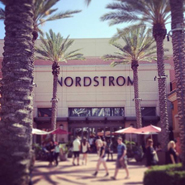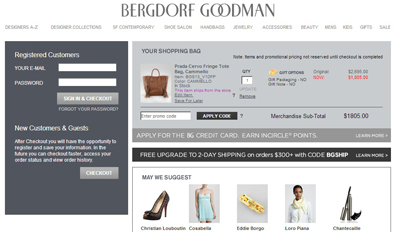
Department stores Nordstrom and Saks Fifth Avenue are ranked as the most digitally progressive retailers because of their large size and ecommerce options, according to a new report from L2 Think Tank.
The "Digital IQ Index: Department Stores 2013" examines the digital competence of global department stores and finds that the larger the store, the more effective its digital strategies. With U.S. department store sales expected to decline 12 percent in 2013 and European department stores leashed to an expected 1.3 percent growth through 2015, the clarion call for enhancing digital tactics is urgent.
"Successful department stores are investing in both online and offline infrastructure in order to increase sales, expedite fulfillment and compete with the range of threats to the category," said Ari Wolfe, lead researcher at L2 Think Tank, New York.
"The findings from Digital IQ Index: Department Stores suggest that bigger is better and that smaller stores, especially those still without ecommerce, will at best struggle to sustain growth," he said.
"Despite the structural challenges, department stores remain the preferred destination both online and off[line] for luxury retail purchases."
The Digital IQ Index: Department Stores 2013 measured 40 retailers across 650 data points on four categories, which are Web site and ecommerce, digital marketing, social media and mobile. Marketers were given Genius, Gifted, Averaged, Challenged and Feeble rankings.
Bigger is better
Nordstrom and Saks were the only two luxury retailers that were given the ranking of Genius.
Bloomingdale's, Neiman Marcus and Net-A-Porter led the pack in the Gifted group.
Holt Renfrew was ranked among the Feeble brands. Despite its popular YouTube video featuring businesswoman and fashion designer Victoria Beckham, the brand does not offer ecommerce.
Eighty-five percent of department stores surveyed are equipped for ecommerce, compared to 58 percent of stores that are equipped for mcommerce.
 Saks Web site
Larger brands are capable of making the substantial investments needed for a holistic digital presence. However, there is still a disconnect between what consumers want and what brands offer.
Sixty-five percent of consumers have engaged in live chat on department store Web sites, while 25 percent of brands offer this service.
Ninety percent of consumers claim that visible user reviews influence purchases, compared to 45 percent of brands that provide user reviews.
Video has been found to torpedo online consumer conversion rates by 160 percent. However, 43 percent of department stores feature online video content.
Fifty-five percent of consumers abandon online shopping carts due to high shipping fees, and 55 percent of department stores have responded with free-shipping offers at thresholds averaging $100.
Bergdorf Goodman and Saks now promote expedited two-day shipping.
Saks Web site
Larger brands are capable of making the substantial investments needed for a holistic digital presence. However, there is still a disconnect between what consumers want and what brands offer.
Sixty-five percent of consumers have engaged in live chat on department store Web sites, while 25 percent of brands offer this service.
Ninety percent of consumers claim that visible user reviews influence purchases, compared to 45 percent of brands that provide user reviews.
Video has been found to torpedo online consumer conversion rates by 160 percent. However, 43 percent of department stores feature online video content.
Fifty-five percent of consumers abandon online shopping carts due to high shipping fees, and 55 percent of department stores have responded with free-shipping offers at thresholds averaging $100.
Bergdorf Goodman and Saks now promote expedited two-day shipping.
 Bergdorf Goodman's checkout page
Nordstrom has seen an 8 percent rise in online sales after providing real-time inventory integration and in-store pickup.
"Forward-thinking high-end department stores such as Nordstrom and Saks take advantage of this with robust ecommerce offerings, advanced CRM and loyalty programs, thriving social media communities and a targeted mobile presence," Mr. Wolfe said.
"Luxury brands, especially in apparel and beauty, still benefit from the department stores format and are likely to remain partners for the near future," he said.
Paved roads
Strengthening a department store's digital presence is only half the battle. The physical location has to be adapted in relation to online developments.
Approximately 50 percent of brands use their Web sites to explain which services are offered at each location, 38 percent display search results on a map and 20 percent outline directions while staying on the same page.
Some of the retailers that scored well digitally also scored well with their multichannel efforts.
For example, Bloomingdale’s, Montblanc and Nordstrom have shown strong multichannel commerce efforts through their email campaigns that drive consumers to purchase both online and in-stores, according to another study from L2 Think Tank.
The “Intelligence Report: Multichannel Retail” found that many luxury brands are not leveraging digital and mobile technologies to drive consumers into their retail locations. Also, for those luxury brands that do use ecommerce, many outsource this commerce to a third-party retailer instead of hosting the technology on their own Web site (see story).
That said, email remains a relevant tool for luxury brands.
"Email accounts for more than three times the upstream referral traffic to department store sites than social media," Mr. Wolfe said.
"Email marketing may be boring, but it remains one of the most effective sales tools, along with search, at 45 percent," he said.
In addition, retailers with an international presence should make sure their Web sites are accessible to consumers in those areas.
"As in other industries, there is growth potential for the category in emerging economies such as China, where only 13 percent of brands currently have a site in the local language," he said.
Final Take
Joe McCarthy, editorial assistant on Luxury Daily, New York
Bergdorf Goodman's checkout page
Nordstrom has seen an 8 percent rise in online sales after providing real-time inventory integration and in-store pickup.
"Forward-thinking high-end department stores such as Nordstrom and Saks take advantage of this with robust ecommerce offerings, advanced CRM and loyalty programs, thriving social media communities and a targeted mobile presence," Mr. Wolfe said.
"Luxury brands, especially in apparel and beauty, still benefit from the department stores format and are likely to remain partners for the near future," he said.
Paved roads
Strengthening a department store's digital presence is only half the battle. The physical location has to be adapted in relation to online developments.
Approximately 50 percent of brands use their Web sites to explain which services are offered at each location, 38 percent display search results on a map and 20 percent outline directions while staying on the same page.
Some of the retailers that scored well digitally also scored well with their multichannel efforts.
For example, Bloomingdale’s, Montblanc and Nordstrom have shown strong multichannel commerce efforts through their email campaigns that drive consumers to purchase both online and in-stores, according to another study from L2 Think Tank.
The “Intelligence Report: Multichannel Retail” found that many luxury brands are not leveraging digital and mobile technologies to drive consumers into their retail locations. Also, for those luxury brands that do use ecommerce, many outsource this commerce to a third-party retailer instead of hosting the technology on their own Web site (see story).
That said, email remains a relevant tool for luxury brands.
"Email accounts for more than three times the upstream referral traffic to department store sites than social media," Mr. Wolfe said.
"Email marketing may be boring, but it remains one of the most effective sales tools, along with search, at 45 percent," he said.
In addition, retailers with an international presence should make sure their Web sites are accessible to consumers in those areas.
"As in other industries, there is growth potential for the category in emerging economies such as China, where only 13 percent of brands currently have a site in the local language," he said.
Final Take
Joe McCarthy, editorial assistant on Luxury Daily, New York
